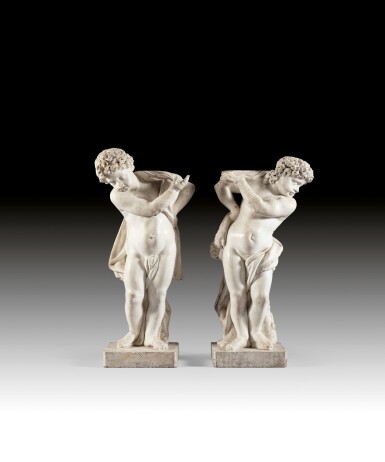
Italo-Flemish, 17th century
A pair of marble atlantes of Hercules and Iphicles | Paire d'Atlantes en marbre figurant Hercule et Iphiclès
Lot Closed
November 10, 03:19 PM GMT
Estimate
15,000 - 20,000 EUR
Lot Details
Description
Italo-Flemish, 17th century
A pair of marble atlantes of Hercules and Iphicles
white marble
H. (Hercules) 135 cm, 53¼in; (Iphicles) 140 cm, 55¼in.
___________________________________________
Italo-Flamand, XVIIe siècle
Paire d'Atlantes en marbre figurant Hercule et Iphiclès
marbre blanc
H. (Hercule) 135 cm, 53¼in ; (Iphiclès) 140 cm, 55¼ in.
Frémontier Gallery, Paris;
Collection from a distinguished Château in France.
___________________________________________
Galerie Frémontier, Paris ;
Collection d'une grande demeure en France.
While Heracles stands out by his exploits, his twin half-brother Iphicles is less famous. However, these two heroes are closely related: their mother, Alcmene, wife of Amphitryon, is seduced by Zeus who appears to her disguised as her husband in his absence.
As a result of this romance, she first gave birth to Iphicles, her husband's son, and the next day Heracles was born after this unfaithful and divine love. From this moment, Iphicles remained at his brother's side and fought for him until his death. He is often associated with physical strength, while Heracles surpasses him thanks to his strategic and civilised spirit.
This pair of marbles shows the two twin brothers in an almost symmetrical position. Heracles can be identified by the animal skin on his shoulder and the club in his hand. Stylistically, these already well-developed children remind the putti of Flemish artists who were active in the 17th century in Italy. Their plump bodies, chubby faces and curly hair recall the work of Giusto de Corte, also known as Josse le Court (1627-1678), a Flemish sculptor, established in Venice in 1657, known for his atlantes in the church of Ospedaletto. Similar characteristics are visible in his marble putto personifying the Allegory of Winter, in the Ca' Rezzonico in Venice.
___________________________________________________
Alors qu'Héraclès brille par ses exploits, son demi-frère jumeau Iphiclès connait une moins grande renommée. Pourtant, ces deux héros sont étroitement liés : leur mère, Alcmène, épouse d'Amphitryon, est séduite par Zeus qui a pris l'apparence de son mari en son absence.
À la suite de cette idylle, elle donna d'abord naissance à Iphiclès, fils de son époux, puis le jour suivant Héraclès naquit de cet amour infidèle et divin. Iphiclès dès lors resta aux côtés de son frère et combattit pour lui jusqu'à sa mort. Il est souvent associé à une force uniquement physique, alors qu'Héraclès le surpasse grâce à son esprit stratégique et civilisateur.
Cette paire de marbres représente les deux frères enfants dans une position presque symétrique. Héraclès peut être identifié par ses attributs, la peau de bête et sa massue. Stylistiquement, ces enfants - déjà bien développés - se rapprochent des putti d'artistes flamands alors actifs au XVIIe siècle en Italie du Nord. Leurs corps potelés, les visages joufflus, leurs chevelures aux boucles épaisses rappellent par exemple les œuvres de Giusto de Corte, dit aussi Josse le Court (1627-1678), sculpteur flamand établit à Venise dès 1657, connu pour ses atlantes de la chiesa dell' Ospedaletto. Ces caractéristiques se retrouvent également dans son putto en marbre personnifiant l'Allégorie de l'Hiver, conservé à la Ca' Rezzonico de Venise.
You May Also Like










